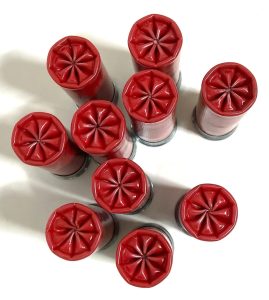Shotgun Shells: Folded Crimp vs. Rolled Crimp
The crimp of a shotgun shell is more than just a method of sealing the shell; it’s a crucial factor that influences the shell’s performance. The folded crimp and the rolled crimp are the two main types used by manufacturers and hand loaders alike. Both have their loyalists, each claiming superior performance based on specific criteria. The decision often boils down to the shooter’s priorities, whether they’re focused on reliability, ease of reloading, or shot pattern consistency.
Folded crimps, usually star-shaped, are perhaps more common in modern factory-loaded ammunition and are frequently seen in hunting and sporting shells. On the other hand, rolled crimps have a storied history and are often associated with specialized or vintage loads. Understanding the differences between these two types can help shooters make more informed choices tailored to their particular needs and preferences.
As with many debates in the firearm community, the “right” choice often varies from one shooter to another. Factors such as the type of shooting activity, the shooter’s level of expertise, and the specific firearm being used can all play a role in determining the most suitable crimp type. Therefore, a closer examination of the advantages and disadvantages of each type is essential.
Folded Crimp: Advantages and Disadvantages
Folded crimps are renowned for their ease of manufacture and consistency, making them a popular choice for factory-loaded ammunition. One significant advantage is their ability to provide a consistent seal, which can enhance the overall reliability of the shell. Consistent sealing means fewer variables affecting the performance of each shot, which is particularly beneficial in competitive shooting scenarios where precision and reliability are key.

However, folded crimps are not without their drawbacks. One of the most cited disadvantages is their impact on shot patterning. The folded crimp can sometimes disrupt the shot as it exits the barrel, leading to a less uniform spread. While this might not be a significant issue for casual shooting, it could be a concern for hunters or competitive shooters who require maximum consistency and precision.
Another disadvantage is that folded crimps can be more challenging to reload. For hand loaders, achieving the same level of consistency as factory-loaded folded crimps can be difficult, requiring meticulous attention to detail and specialized equipment. This can make folded crimps less appealing for those who prefer to reload their shells, particularly if they are looking to optimize performance for specific applications.
Rolled Crimp: Benefits and Potential Drawbacks
Rolled crimps are often favored by those who value shot pattern consistency and the ability to reload shells with ease. One of the primary benefits of a rolled crimp is its minimal impact on the shot pattern. This type of crimp provides a more uniform spread, which can be beneficial for hunting or target shooting where precision is paramount. Additionally, rolled crimps allow for a higher payload, as less shell length is taken up by the crimp itself.

Reloading enthusiasts often prefer rolled crimps because they are easier to apply and can be more forgiving when it comes to achieving a consistent seal. This makes them an attractive option for those who hand load their ammunition and seek to maximize their shells’ performance. Rolled crimps also offer the advantage of being reusable, which can be a cost-effective solution for avid shooters.
Despite these benefits, rolled crimps do have their limitations. They are generally not as durable as folded crimps, which can affect the longevity and reliability of the shell under harsh conditions. Additionally, rolled crimps can be less effective at maintaining a tight seal over time, especially if the shells are subject to varying environmental conditions. This could potentially lead to reduced performance or even misfires in extreme cases.
Which Crimp is Superior for Your Shooting Needs?
Determining which crimp is superior largely depends on the individual shooter’s requirements and the specific context in which the ammunition will be used. For example, competitive shooters and hunters who prioritize shot pattern consistency and ease of reloading might find rolled crimps to be more advantageous. The ability to achieve a uniform spread and the ease of reloading can provide a significant edge in these scenarios.
Conversely, those who prioritize reliability and durability might lean towards folded crimps. The consistent seal and robust nature of folded crimps make them a solid choice for factory-loaded ammunition and situations where environmental factors are a concern. Additionally, the prevalence of folded crimps in modern ammunition means shooters may have more options to choose from when purchasing factory-loaded shells.
Ultimately, the choice between a folded crimp and a rolled crimp comes down to personal preference and shooting needs. Both types have their merits and potential drawbacks, and neither is universally superior. Shooters should consider their specific applications, whether it’s hunting, competitive shooting, or casual target practice, and weigh the pros and cons of each crimp type accordingly.
# # #


Comments